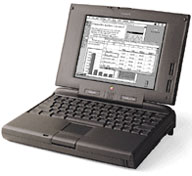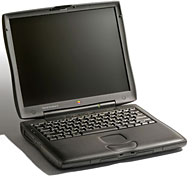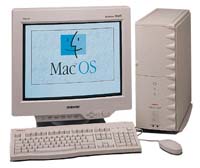I've been writing for Low End Mac for so long now that I can't
remember exactly when it was that my scribblings first appeared on the
site. Statistics oriented Dan Knight can probably tell us, but I'm
guessing that it was probably sometime in 1998 [it was Sept. 9, 1999 - dk]. My entry into Mac
Web online journalism began with a bit of dabbling that led to a
regular gig with the now long defunct MacTimes Network (I still think that was
a great name), with which Dan and Low End Mac (LEM) were affiliated,
and when MacTimes folded, I was sort of "inherited" by LEM.
Hard to believe it's been almost 13 years. I was still in my
mid-40s, and now I just cashed my first Canada Pension Plan cheque last
week, having opted-in at 60 at a reduced benefit, although I plan to
keep working for several years yet, health permitting.
 Philosophically,
I've always considered the low-end Mac concept more an orientation and
a state of mind than any hard-boundaried hardware prescription. When I
first came in board, I was on my third Mac and my first PowerBook - a
5300 that I had picked up
remaindered at the end of its production run. The 5300 was definitely
low-end, the base model with an anemic 100 MHz PowerPC 603e processor,
a 500 MB hard drive, and its 9.5" grayscale passive matrix display was
actually smaller and significantly lower resolution (640 x 480) than
the 9.7" 1024 x 768 screen in my iPad 2.
Philosophically,
I've always considered the low-end Mac concept more an orientation and
a state of mind than any hard-boundaried hardware prescription. When I
first came in board, I was on my third Mac and my first PowerBook - a
5300 that I had picked up
remaindered at the end of its production run. The 5300 was definitely
low-end, the base model with an anemic 100 MHz PowerPC 603e processor,
a 500 MB hard drive, and its 9.5" grayscale passive matrix display was
actually smaller and significantly lower resolution (640 x 480) than
the 9.7" 1024 x 768 screen in my iPad 2.
 My next PowerBook was low-end as well, being the
entry-level 12" display 233 MHz version of the PDQ revision 2 WallStreet G3
Series with a 2 GB hard drive. However, it was a massive leap ahead
in performance from the 5300, and the price seems anything but low-end
by 2012 standards, being in the ballpark of $3,400 Canadian, and that
was with a discount I got thanks to being a sales agent for a Mac
reseller at the time. It was definitely the most expensive Mac I've
ever owned, and, ironically, the only one that ever suffered a major
hardware failure while still in service as my number one Mac - a fried
CPU - which was fortunately easily repaired with a scrounged processor
daughtercard.
My next PowerBook was low-end as well, being the
entry-level 12" display 233 MHz version of the PDQ revision 2 WallStreet G3
Series with a 2 GB hard drive. However, it was a massive leap ahead
in performance from the 5300, and the price seems anything but low-end
by 2012 standards, being in the ballpark of $3,400 Canadian, and that
was with a discount I got thanks to being a sales agent for a Mac
reseller at the time. It was definitely the most expensive Mac I've
ever owned, and, ironically, the only one that ever suffered a major
hardware failure while still in service as my number one Mac - a fried
CPU - which was fortunately easily repaired with a scrounged processor
daughtercard.
 I actually have
owned a couple top-of-the-line Macs - 500 MHz Pismo PowerBook
G3 that I swapped my G4 Cube for back in 2001 (and
still have in regular service), and the 1.33 GHz 17" PowerBook
G4 that I purchased as an Apple Certified Refurbished unit in
2006. Of course, neither of them could still claim high-end status at
the times I acquired them.
I actually have
owned a couple top-of-the-line Macs - 500 MHz Pismo PowerBook
G3 that I swapped my G4 Cube for back in 2001 (and
still have in regular service), and the 1.33 GHz 17" PowerBook
G4 that I purchased as an Apple Certified Refurbished unit in
2006. Of course, neither of them could still claim high-end status at
the times I acquired them.
 Along the road there
were also a SuperMac S900 tower, a
couple more Pismos bought as stripped chassis and screen, a 700 MHz iBook G3, a PowerBook 1400, and my current
workhorse Mac, a Late
2008 Aluminum Unibody MacBook, my first (and as yet only) Intel Mac,
which is now definitely low-end at this point and barely makes the cut
to support OS X 10.7 Lion,
which I haven't as yet been persuaded to adopt anyway.
Along the road there
were also a SuperMac S900 tower, a
couple more Pismos bought as stripped chassis and screen, a 700 MHz iBook G3, a PowerBook 1400, and my current
workhorse Mac, a Late
2008 Aluminum Unibody MacBook, my first (and as yet only) Intel Mac,
which is now definitely low-end at this point and barely makes the cut
to support OS X 10.7 Lion,
which I haven't as yet been persuaded to adopt anyway.
The two somewhat breathed-on Pismos I still use daily are
über-low-end, running OS X
10.4 Tiger, and my other low-end "Mac" these days is a 16 GB WiFi
iPad 2, which is gradually roping me in despite it being a second- or
third-class computing platform in several important contexts compared
to a real Mac.
Notwithstanding being sort of a power user, I still think of myself
as a low-ender, and that goes for software as well as hardware, my
most-used productivity applications being Tom Bender's $15 shareware
Tex-Edit Plus, the little freeware
minimal database app
Tincta, Bare Bones Software's free but powerful TextWrangler, the superb
little freeware image resizer and basic editor ToyViewer.
On the iPad, I use the free versions of the excellent
PlainText and
Nebulous Notes text processors, plus Infovole's excellent trio of
inexpensive text processors -
Textkraft,
Schreibkraft, and
1a Easy Writer, which sell for seven, three, and one dollars
respectively.
Looking ahead, I'm going to try to get at least another year out of
the MacBook, aided by the now nine-month-old iPad 2, which I still
consider the apogee of Apple talent computer development - and
preferable to the fatter, heavier, hotter-running, slow-to-charge new
third-generation iPad, regardless of
how nice the latter's Retina Display is.
As noted, I'm not enchanted by OS X Lion or it's Mountain Lion eventual successor.
However, I'll no doubt get assimilated eventually, either when I
finally buy my next Mac or if some compatibility issue makes installing
it (hopefully on the MacBook's second hard drive partition) necessary.

 Philosophically,
I've always considered the low-end Mac concept more an orientation and
a state of mind than any hard-boundaried hardware prescription. When I
first came in board, I was on my third Mac and my first PowerBook - a
Philosophically,
I've always considered the low-end Mac concept more an orientation and
a state of mind than any hard-boundaried hardware prescription. When I
first came in board, I was on my third Mac and my first PowerBook - a
 My next PowerBook was low-end as well, being the
entry-level 12" display 233 MHz version of the
My next PowerBook was low-end as well, being the
entry-level 12" display 233 MHz version of the  I actually have
owned a couple top-of-the-line Macs -
I actually have
owned a couple top-of-the-line Macs -  Along the road there
were also a
Along the road there
were also a 
